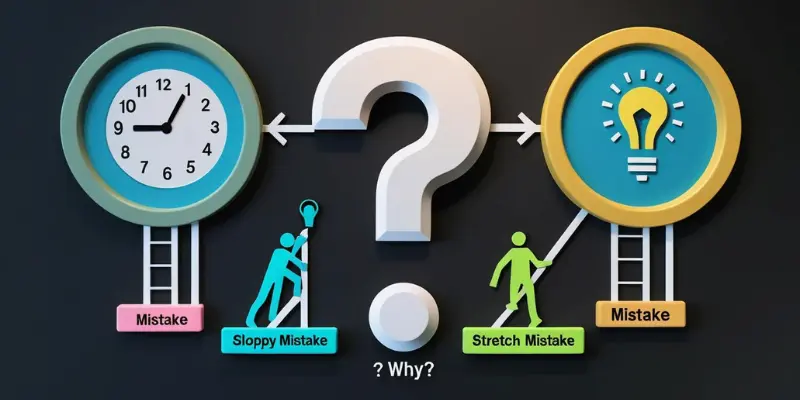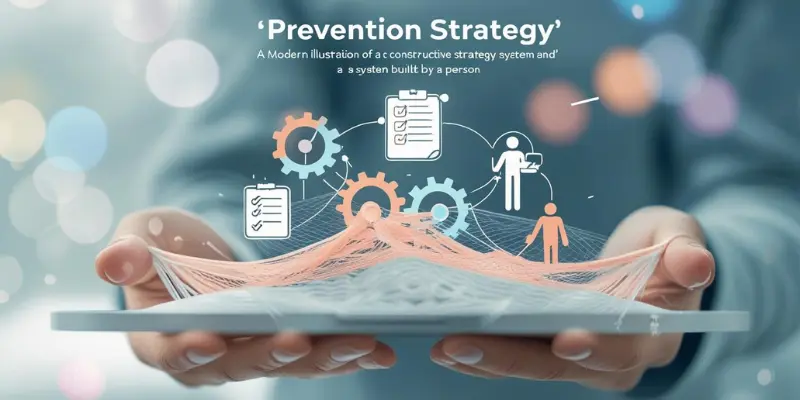7 Ways to Recover from a Mistake at Work (and Bounce Back Stronger)
Published: 12/08/2025
Every professional has experienced that stomach-dropping moment when they realize they’ve made a mistake. It’s the rush of panic, the sinking feeling, as you come face-to-face with the reality that something has gone wrong. It’s uncomfortable, overwhelming, and for some, it can even feel career-threatening. But here’s the truth: making mistakes is not only inevitable—it’s an essential part of your professional journey.
In this guide, we’re not just going to help you survive that moment of panic. We’re going to show you how to use it as a springboard for growth. Mistakes are often seen as setbacks, but in reality, they are powerful learning opportunities. This post will give you a step-by-step roadmap to recover from a mistake, not just by fixing the immediate issue, but by shifting your mindset for the long term.
Whether you’re an anxious professional trying to regain your footing, a proactive learner seeking to bounce back better, or a conscious leader wanting to lead with integrity, this guide is for you. You’ll learn how to acknowledge and address mistakes, extract valuable lessons, and build habits that protect you from repeating them. It’s time to transform the discomfort of mistakes into a stepping stone for your growth and success.
The Immediate Aftermath: Acknowledge and Assess
The first 60 minutes after a mistake can feel like a whirlwind. The pressure to act fast is intense, but it’s crucial to approach this moment with clarity. In these critical moments, your actions (or inactions) will define how you handle the situation. This section is your rescue plan, a guide to taking the right steps immediately after realizing a mistake.
Acknowledge It Quickly and Directly
The key to moving past any mistake is to acknowledge it immediately. Waiting, hoping it will somehow resolve itself, or pretending it didn’t happen only makes things worse. When you own your mistake early on, it signals to others that you are responsible and accountable—two qualities that build trust in your professional reputation.
What to Say to Your Boss:
- Be honest: “I made an error in my report, and I’m already working to fix it.”
- Own it: Avoid any defensive language. Say, “This was my mistake,” instead of “It happened because…”
- Offer a solution: “I’m looking into this now and will have a resolution by [time].”
What NOT to Say:
- Don’t blame others: “It happened because my team didn’t give me the right data.” Even if others contributed, avoid pointing fingers.
- Don’t make excuses: “I was in a rush and didn’t have enough time.” While context can be helpful later, excuses undermine your credibility.
The goal here is to demonstrate honesty and accountability while showing that you are already taking action to correct the issue. The sooner you acknowledge the mistake, the sooner you can focus on fixing it.
Assess the Damage (Objectively)
Once you’ve acknowledged the mistake, it’s time to assess the scope of the damage. This will help you understand how big the problem is and what steps are needed to address it.
- Separate facts from emotions: In the heat of the moment, it’s easy to let fear, embarrassment, or frustration cloud your judgment. Take a deep breath and focus on the facts. What exactly went wrong? What part of the project or process was affected?
- Determine the impact: Who does this mistake affect? Is it something that can be fixed quickly, or will it take time to resolve? Assessing the severity helps you plan the next steps effectively.
- Identify immediate corrective actions: What can you do now to minimize the damage? For instance, if it’s a report error, can you send a corrected version immediately? If it’s a process issue, can you alert the team or stakeholders to take precautions?
Let’s consider a case study of Jessica, an employee at a marketing agency, who accidentally sent an incomplete client proposal to a major client. After realizing the mistake, she immediately acknowledged the error to her manager and the client, taking full responsibility. By assessing the situation calmly, she realized that only the budget section was missing and that the rest of the proposal was intact. Jessica sent a revised proposal within an hour, alongside a sincere apology. Because of her honesty and quick action, the client trusted her more, and her manager appreciated her transparency, reinforcing Jessica’s reputation for integrity. Her prompt action not only fixed the issue but also earned her trust from both the client and her boss.
By acknowledging the mistake quickly and assessing the damage objectively, you set yourself up for a smooth recovery. The faster you act, the better chance you have to regain control and begin the process of fixing the problem.
The Practical Fix: Stop the Bleeding and Find a Solution
Once you’ve acknowledged the mistake and assessed its impact, your next priority is to stop the bleeding—that is, fix the problem and minimize any further damage. This is where your focus shifts from the initial crisis to finding a practical solution. Here’s how to tackle this:
Identify the Root Cause (The “Why”)
Before you can fix the issue, you need to understand why it happened in the first place. Was the mistake a result of careless oversight, a stretch of your capabilities, or a misunderstanding? Categorizing the mistake will help you better address it.
- Sloppy Mistake: These mistakes happen when you don’t give enough attention to detail. It’s usually a result of rushing, neglecting the small things, or cutting corners. If the mistake falls into this category, it’s often correctable with a little more effort and attention in the future.
- Stretch Mistake: This occurs when you take on a challenge beyond your current ability or knowledge—perhaps you’re pushing your limits, and the mistake is part of learning. While more difficult to fix, these mistakes often lead to growth when acknowledged and corrected.
- Aha-Moment Mistake: This is when you make a mistake that leads to an important insight or learning opportunity. While these can be frustrating at the moment, they often have the most long-term value, as they give you the chance to correct systemic issues in your workflow or thought process.

One helpful method to dive deeper into the root cause of the problem is the “5 Whys” technique, a problem-solving tool used to get to the core of an issue by asking “Why?” five times in succession. For example, if a project was delayed, you might ask:
- Why was the project delayed? – Because I missed the deadline for submitting the report.
- Why did I miss the deadline? – Because I didn’t manage my time well.
- Why didn’t I manage my time well? – Because I didn’t prioritize the tasks properly.
- Why didn’t I prioritize the tasks properly? – Because I didn’t clarify the most urgent tasks.
- Why didn’t I clarify the most urgent tasks? – Because I didn’t have a clear overview of the project timeline.
By the fifth “Why,” you may uncover that your core problem lies in poor time management or unclear communication about priorities, which you can then address.
Take Corrective Action (The “How”)
Once you’ve identified the root cause, it’s time to shift your focus to correcting the mistake. A clear, concise plan will not only fix the issue but also help prevent it from happening again.
- Develop a Clear Plan: Start by outlining the necessary steps to resolve the problem. This plan should be specific, actionable, and realistic. For example, if a project was delayed due to missed deadlines, your corrective action might include:
- Setting clearer milestones.
- Communicating progress more frequently.
- Setting reminders or scheduling dedicated time for each task.
- Mitigate the Impact: In some cases, the impact of the mistake may be irreversible or immediate (e.g., a report sent with incorrect data). In this case, you’ll need to act swiftly to minimize the damage. This might involve apologizing to the affected parties, correcting the error as quickly as possible, and offering a concrete solution (such as a revised report or additional resources).
- Communicate Your Solution to Stakeholders: Transparency is key. Once you have a plan in place, you need to communicate it effectively to all relevant stakeholders. Whether it’s your boss, a team member, or a client, let them know exactly what steps you’re taking to resolve the issue. This shows accountability and reassures them that you’re on top of the situation.
For example, you might say:
- “I’ve identified the root cause of the delay, and here’s my plan to get us back on track. I will have the updated proposal ready by the end of the day, and I will ensure that moving forward, we have more frequent progress updates to avoid similar delays.”
Let’s consider David, a project manager who missed a client’s key deadline because his team wasn’t communicating clearly about project milestones. After identifying the problem through the 5 Whys process, David realized that communication and time management were the core issues. His solution? He implemented a shared project calendar for real-time updates, scheduled weekly check-ins with his team, and established more granular deadlines to track progress. He communicated this plan to the client, apologized for the delay, and assured them that moving forward, the project would be managed more efficiently. By acknowledging his mistakes, creating a clear solution, and communicating effectively, David rebuilt trust and kept the project on track.
The Practical Fix is about taking decisive action. By identifying the root cause and taking corrective action with a well-thought-out plan, you’ll not only resolve the immediate problem but also lay the groundwork to prevent similar mistakes in the future. This proactive approach builds credibility and positions you as someone who can handle challenges and learn from them.
The Reframe: From Failure to a Powerful Learning Opportunity
One of the most crucial shifts you can make after a mistake is in your mindset. It’s easy to slip into the narrative that you’re a failure, that this mistake defines your capabilities, or that you’ve somehow hit a dead end. But this line of thinking is not only unproductive—it’s inaccurate. The truth is, mistakes are not roadblocks; they are learning opportunities. Shifting your perspective from “I am a failure” to “I have a new data point for growth” can turn a potentially demoralizing experience into a powerful step forward.
The Power of Self-Compassion
Self-compassion is the first essential tool you need to reframe your thinking. It’s about being kind to yourself instead of beating yourself up for making a mistake. When we mess up, it’s natural to feel frustrated or even ashamed. However, how we talk to ourselves in those moments plays a huge role in how quickly we can move forward.
- Be kind, not critical: Instead of thinking, “I’m so stupid for making this mistake,” try reframing it to, “I made an error, but that doesn’t define my entire capability.” Think of how you’d treat a friend who made a mistake—offer yourself the same kindness.
- Treat yourself with understanding: Acknowledge that mistakes happen, especially when you’re pushing your limits or taking on new challenges. Reassure yourself that no one is perfect, and every mistake is an opportunity to grow.
- Forgive yourself: Mistakes are not a reflection of your worth. They are just one part of the learning process. Forgiving yourself opens the door for positive growth, whereas self-criticism often keeps you stuck in a negative cycle.

Integrating the Concept of “Cognitive Reframing” to Move Past Shame
Cognitive reframing is a psychological technique where you change the way you view a situation to shift your emotional response. It’s particularly powerful when trying to move past feelings of shame after making a mistake.
- Shift your focus: Instead of focusing on the mistake itself, focus on what you can control next. Ask yourself, “What can I learn from this?” This simple shift from self-blame to growth helps you move forward without carrying emotional baggage.
- Change your inner narrative: Every time you feel that shame creeping in, challenge it. Instead of thinking, “I’ll never recover from this,” reframe it to, “This is a chance to improve and become more skilled at handling challenges.”
- Embrace the process: Remember, mistakes are not failures—they’re just part of the process. When you shift from seeing mistakes as setbacks to seeing them as stepping stones, you begin to build resilience.
Extracting the Lesson
Once you’ve practiced self-compassion and reframed your mindset, it’s time to extract the lesson from the mistake. This is where true growth happens: by understanding what went wrong, what you learned from it, and how you can use that knowledge moving forward.
- What did this mistake teach you about your skills?: Every mistake highlights areas for improvement, whether it’s communication, time management, or technical skills. Ask yourself:
- Did I misjudge the time required to complete a task?
- Did I fail to communicate clearly with my team?
- Was my knowledge of the task or subject insufficient?
For example, if you made an error while preparing a report because you rushed through it, the lesson might be that you need to prioritize thoroughness over speed in future tasks.
- What did this mistake teach you about your process or environment?: Mistakes often reflect deeper issues in processes or systems. Perhaps the issue wasn’t entirely about your own performance but rather about the tools or processes in place. Ask yourself:
- Was the process unclear or inefficient?
- Did I have all the information I needed?
- Was I working in an environment that supported my success?
For example, if the mistake was caused by a miscommunication with a colleague, the lesson might be to set clearer expectations or communicate more frequently.
Take Mark, a software developer, who pushed out a buggy update to a client’s app. At first, he was overwhelmed by feelings of shame, thinking that his career might be on the line. However, instead of letting that shame consume him, he practiced self-compassion: “I made a mistake, but I’m learning and growing from this.” He then used cognitive reframing to shift his focus: “This is a valuable learning moment. I need to improve my testing process.” Mark took the opportunity to reflect on his technical skills and identified areas where he could be more meticulous. Additionally, he improved the communication flow with his team to prevent future mistakes.
By shifting his perspective, Mark was able to extract valuable lessons, not just from the mistake itself, but from his entire approach to development. This reframing helped him bounce back stronger than before, improving both his technical skills and his work processes.
The Reframe is about more than just fixing the mistake. It’s about using the experience to redefine how you approach challenges in the future. Through self-compassion, cognitive reframing, and extracting lessons, you transform a setback into an opportunity for real growth. With this mindset, you can continually improve and become more resilient in the face of any challenge.
The Long-Term Playbook: Building a Stronger You
A mistake isn’t just a one-off event—it’s an opportunity for personal growth and lasting improvement. When you approach mistakes as learning experiences, you can build stronger habits, improve your skills, and enhance your professional resilience. This section focuses on how to turn mistakes into a long-term strategy for success by developing prevention methods and reinforcing your credibility through ongoing improvement.
Create Your Prevention Strategy
The best way to ensure that a mistake doesn’t repeat itself is to create a prevention strategy—a system that minimizes the chances of similar errors happening in the future. Think of it like building a safeguard for your work habits.
- Implement a new checklist or process: After identifying the root cause of your mistake, create a checklist or update an existing process to address the problem. This ensures you are taking preventive measures and not repeating the same steps that led to the mistake.
- For example, if you missed a deadline because you didn’t manage your tasks effectively, consider implementing a new task prioritization system. Use a to-do list or project management tool to break your tasks down into smaller, more manageable chunks with specific deadlines.
- Regular review and updates: Build in periodic reviews of your processes to ensure they stay effective. Mistakes happen when systems become outdated or inefficient. A routine check-in will help you identify areas for continuous improvement.
- Document lessons learned: Keep a record of each mistake and the lessons learned from it. Over time, this becomes a valuable resource that helps you avoid similar pitfalls in the future.
- Seek out a mentor or coach: Finding someone who can guide you as you grow is invaluable. A mentor can offer advice on improving your approach to work, managing stress, and developing effective habits. A coach can help you focus on areas for growth and give you a clearer perspective on what skills or processes need fine-tuning.

Rebuilding Trust and Credibility
Once you’ve implemented your prevention strategy, the next step is to rebuild trust—with yourself, your boss, and your team. Mistakes can be damaging, but they don’t have to define your reputation. How you follow up and demonstrate growth is what truly matters.
- Follow up consistently: It’s not enough to acknowledge a mistake once and move on. You must follow through on your corrective actions. Communicate the steps you’ve taken to resolve the issue and show how you’ve applied the lessons learned.
- For example, if you’ve made a mistake on a report, following up means sharing the updated report and explaining the improvements made. It also includes providing a timeline for additional checks you’ve implemented to ensure it doesn’t happen again.
- Show how you’ve learned: Trust is rebuilt through actions, not just words. When you’ve learned from a mistake, demonstrate that learning by improving your performance. Share the changes you’ve made, whether it’s better communication, improved skills, or more effective time management.
- Be transparent: Continue being honest and open. People appreciate transparency, especially when you admit mistakes and show how you’re actively working to improve. This reinforces your integrity and shows you are not afraid of accountability.
Suggested Integration Point: Research shows that leaders who admit their mistakes are perceived as more trustworthy than those who deflect blame or refuse to acknowledge their faults. A study by Harvard Business Review found that when leaders own their mistakes, employees are more likely to trust them, leading to higher team morale and stronger leadership credibility. This data point underscores the importance of not only admitting your mistakes but actively demonstrating the lessons learned.
Sophia, a senior marketing manager, had been leading a major product launch that missed its target due to a miscommunication in her team. After recognizing the mistake, she implemented a more detailed communication strategy and introduced a weekly team check-in to ensure everyone was aligned. Sophia also reached out to her team to explain the changes she was making and encouraged them to hold her accountable. As a result, her team appreciated her honesty, and they saw her as a more trustworthy leader. Her reputation as a strong, transparent manager was solidified because she didn’t just correct the mistake; she took ownership and worked with her team to prevent it from happening again.
The Long-Term Playbook is about turning mistakes into sustainable growth. By creating prevention strategies, following up with concrete actions, and rebuilding trust, you can transform any error into an opportunity for lasting improvement. This process doesn’t just help you avoid future mistakes—it helps you grow as a more effective, confident, and trustworthy professional.
Expert-Level Mistake Management: What Conscious Leaders Do Differently
For leaders, managing mistakes goes beyond just handling them when they occur. It’s about creating an environment that anticipates and prevents mistakes, and most importantly, embraces them as opportunities for growth. This section is dedicated to those in leadership roles—whether you’re leading a team or managing a department—who are looking to foster a culture of learning and psychological safety. As a conscious leader, your approach to mistakes can be the difference between a high-performing team and one that is paralyzed by fear.
The Leader’s Pre-Mortem: How to Anticipate and Prevent Mistakes Before They Happen
One of the most effective techniques for anticipating and preventing mistakes is the Pre-Mortem. Unlike a post-mortem, which looks at the mistakes that have already happened, a pre-mortem is a proactive strategy where leaders and teams envision the potential pitfalls of a project before it even starts.
- What is a Pre-Mortem?: A pre-mortem involves gathering your team to brainstorm potential risks or mistakes that could arise in the course of a project. You take time to reflect on why things might go wrong, not after the fact, but before you dive into the work.
How to conduct a Pre-Mortem:
- Set the stage: Gather your team and explain the concept—this isn’t about assigning blame, but about thinking through what could go wrong and how to prevent it.
- Visualize failure: Ask everyone, “If this project were to fail, why would it fail?” Encourage people to think creatively and consider everything, from missed deadlines to miscommunications.
- Identify key risks: As a group, identify the most likely or damaging issues. These could include time constraints, lack of resources, or unclear responsibilities.
- Create solutions: After identifying the risks, discuss practical steps to avoid these problems. Develop contingency plans for the top risks identified.

The Pre-Mortem process helps you spot potential problems early, allowing you to put safeguards in place and make necessary adjustments before any major mistakes occur. It’s about preemptively managing risk and empowering your team to think critically about their work from the start.
Creating Psychological Safety: Building a Culture Where Mistakes Are Seen as Learning Opportunities, Not Career-Ending Events
One of the most critical aspects of effective leadership is creating a culture where mistakes are not feared, but seen as opportunities for growth. Psychological safety is the cornerstone of this environment.
- What is Psychological Safety?: Psychological safety refers to an environment where individuals feel safe to take risks, share their ideas, and admit mistakes without fear of judgment, rejection, or negative consequences. This doesn’t mean that mistakes are excused, but they are treated as part of the learning process rather than as career-ending failures.
- How to Create Psychological Safety:
- Encourage open communication: Let your team know that mistakes won’t lead to punishment. Create channels for them to speak openly about challenges without fear of retribution.
- Reinforce positive responses: When a team member admits a mistake, praise their honesty. Show appreciation for the courage it takes to admit errors openly.
- Make mistakes a learning experience: After a mistake is made, shift the focus to what can be learned from it. Ask questions like, “What can we improve moving forward?” rather than focusing on blame.
When psychological safety is established, your team is more likely to take risks, innovate, and be fully engaged. Mistakes become valuable feedback, not something to be avoided at all costs. Leaders who cultivate psychological safety foster greater collaboration and higher performance.
Vulnerability as a Strength: The Importance of a Leader Admitting Their Own Mistakes to Foster an Open Environment
In leadership, one of the most powerful tools you have is your vulnerability. When you, as a leader, admit to your own mistakes, it sets the tone for your entire team. It shows them that no one is above making mistakes, and more importantly, it creates a culture where it’s safe to be human.
- Why is vulnerability a strength? Vulnerability is often seen as a weakness in many professional environments, but in leadership, it’s the opposite. Leaders who admit their own mistakes not only earn the respect of their teams, but they also create an open environment where everyone feels comfortable taking responsibility and learning from their own missteps.
- How to Use Vulnerability Effectively:
- Own up to your mistakes: When you make an error, openly admit it. For instance, “I misjudged the situation, and I take full responsibility for that. Here’s what I’m doing to fix it.”
- Be transparent about your learning process: Share the lessons you’ve learned from the mistake. This shows your team that growth is continuous and that mistakes are part of the journey.
- Foster an open dialogue: Encourage team members to be transparent about their mistakes and to see them as learning opportunities. This not only boosts morale but also encourages a culture of growth.
“Great leaders admit their mistakes and show their teams that it’s okay to fail. In fact, failure is an opportunity to learn and grow.”
This idea of embracing vulnerability is a key trait of successful leaders who inspire trust, respect, and loyalty from their teams. When your team sees that you are willing to admit your mistakes and work to correct them, they are more likely to mirror that behavior.
Expert-Level Mistake Management isn’t just about managing the immediate aftermath of an error; it’s about setting the stage for preventative strategies and fostering a culture where mistakes are embraced as part of the learning process. By using techniques like the Pre-Mortem, promoting psychological safety, and showing vulnerability, conscious leaders can create an environment where mistakes aren’t feared but used as opportunities for innovation and growth.
Common Mistakes to Avoid: From Your Competitors
While it’s important to know how to recover from a mistake, it’s equally important to be aware of the common pitfalls that others often fall into. These mistakes can not only prolong the recovery process but can also damage your reputation and hinder your growth. In this section, we’ll take a closer look at some of the most prevalent missteps and how to avoid them—ensuring your approach remains both effective and professional.
Ignoring or Trying to Hide the Mistake
One of the biggest mistakes you can make after an error is to ignore it or try to hide it. It might seem tempting to hope the mistake goes unnoticed or to downplay its impact, but this only exacerbates the problem.
- Why it’s damaging: Ignoring a mistake or trying to conceal it often leads to greater consequences later on. It may give the impression that you’re avoiding accountability, which can damage your professional integrity.
- How to avoid it: Acknowledge the mistake immediately, even if it’s uncomfortable. Let others know you’re aware of the error and that you are actively working to fix it. Transparency and honesty are key to maintaining trust, especially with colleagues, clients, and supervisors.
Making Excuses or Blaming Others
Another common pitfall is making excuses or shifting the blame onto others. It’s natural to want to protect yourself from the negative consequences of a mistake, but pointing fingers or making excuses only weakens your credibility and prevents you from taking responsibility.
- Why it’s damaging: When you blame others, you show a lack of accountability. Even if others played a part in the mistake, shifting the focus away from yourself doesn’t help resolve the issue—it only creates conflict and erodes trust.
- How to avoid it: Own up to your role in the mistake. If others were involved, you can acknowledge their part without deflecting responsibility from your own. For instance, you might say, “I missed an important detail in the report, and I’ll ensure that moving forward, I double-check this with the team to prevent it from happening again.”
Dwelling on the Mistake and Letting It Paralyze You
It’s easy to fall into the trap of dwelling on the mistake, especially if it feels significant. The emotions of guilt, shame, and frustration can keep you stuck in the past, preventing you from moving forward. But spending too much time focusing on the mistake often leads to paralysis, making it harder to take action.
- Why it’s damaging: Dwelling on the mistake prevents you from learning and growing from the experience. The longer you stay stuck in your feelings of shame, the harder it becomes to take the necessary steps to correct the issue.
- How to avoid it: Shift your focus quickly. After acknowledging and understanding the mistake, move your attention to finding solutions and creating new habits. Remind yourself that mistakes are part of the learning process, not something to be ashamed of. Use self-compassion to keep a positive and productive mindset.
Failing to Follow Up and Demonstrate New Learning
One of the most damaging mistakes you can make is failing to follow up after a mistake. Simply fixing the error isn’t enough; you need to demonstrate that you’ve learned from it and put strategies in place to prevent it from happening again. Not following up leaves a perception that the mistake was a one-time occurrence rather than a learning opportunity.
- Why it’s damaging: Failing to show that you’ve learned from a mistake can make you appear unaware or uncommitted to growth. It gives the impression that the issue wasn’t taken seriously or addressed properly, potentially leading others to doubt your competence.
- How to avoid it: Follow up by communicating the changes or improvements you’ve implemented as a result of the mistake. This could involve sharing your new processes, explaining what you’ve learned, or providing regular updates on progress. If appropriate, check in with the person impacted by the mistake to ensure the issue is fully resolved.
By avoiding these common pitfalls, you set yourself up for a successful recovery. Acknowledging the mistake, taking responsibility, and showing that you’ve learned from it will demonstrate your maturity, professionalism, and commitment to growth. In the long run, these steps will not only help you overcome the mistake but also strengthen your relationships and reputation in the workplace.
Conclusion: Your Roadmap to Resilience
Making a mistake at work doesn’t have to be the end of your confidence or your career—it can be the beginning of something even more powerful: a new chapter of personal and professional growth. The key is to shift your mindset and approach mistakes as opportunities to learn, improve, and build resilience. By following the 7-step process of acknowledging, assessing, correcting, and learning, you transform a moment of dread into a catalyst for growth.
Mistakes aren’t signs of failure—they’re signals that you’re pushing your boundaries, taking risks, and trying to improve. The difference between a mistake that holds you back and one that propels you forward is how you respond. Instead of letting mistakes paralyze you, be proactive. Take immediate action, reflect on the lessons, and use that knowledge to make smarter, more informed decisions moving forward.
Resilience is built through these small, everyday moments where you confront failure, learn from it, and bounce back stronger. So, remember: the road to success is paved with mistakes, and it’s how you handle them that determines your future.
“What is one mistake you’ll learn from this week? Share your experience below and join the conversation.”
By sharing your own experiences, you’re not only helping yourself process your growth, but you’re also contributing to a broader conversation on resilience and learning. Let’s all take this journey together, learning from one mistake at a time.
FAQs for Taking Action and Moving Forward
The first step is to “acknowledge” the mistake quickly and take responsibility. Then, assess the damage by separating facts from emotions. After that, focus on implementing corrective actions and communicating your solution to relevant stakeholders.
To prevent repeating a mistake, “identify the root cause” and create a prevention strategy. Implement new checklists, improve communication, or adjust your processes. Regularly review and refine these strategies to stay on track.
Absolutely. “Admitting mistakes” shows “accountability” and “integrity”, which builds trust with your boss. It also demonstrates your commitment to learning and improving. Be honest, offer a solution, and show that you’re taking steps to prevent future errors.
Practice “self-compassion”. Recognize that mistakes are part of growth, and avoid being overly critical of yourself. Shift your focus to learning from the error and how you can improve moving forward.
Instead of seeing mistakes as failures, view them as valuable “learning opportunities”. Shift from a “failure” mindset to a “growth” mindset, seeing each mistake as a data point for improvement.
Rebuilding trust involves being “transparent”, following through with corrective actions, and showing consistent improvement. Communicate your plan, demonstrate that you’ve learned, and follow up with actions that show progress.
While acknowledging the mistake is important, “focus on the solution”. Quickly shift from dwelling on the error to developing an action plan that addresses the issue and prevents it from happening again.
Use, “cognitive reframing” to see the mistake as an opportunity to learn rather than as a failure. Reflect on what the mistake taught you about your skills, processes, and environment. Extract actionable lessons that help you grow.
Create a psychologically safe environment where mistakes are seen as learning opportunities. Lead by example by admitting your mistakes and showing how you’ve learned from them. Encourage open communication and constructive feedback.
After acknowledging and addressing the mistake, focus on “learning and growth”. Seek out mentorship, develop new habits to prevent future mistakes, and follow up with your team or stakeholders to show how you’ve corrected the issue.

- Be Respectful
- Stay Relevant
- Stay Positive
- True Feedback
- Encourage Discussion
- Avoid Spamming
- No Fake News
- Don't Copy-Paste
- No Personal Attacks



- Be Respectful
- Stay Relevant
- Stay Positive
- True Feedback
- Encourage Discussion
- Avoid Spamming
- No Fake News
- Don't Copy-Paste
- No Personal Attacks





